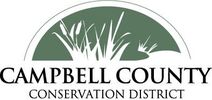Ever wonder what a Conservation District is? Learn more with this short video!
History
During the 1930's, the Dust Bowl made the need to conserve natural resources, particularly soil, very clear. Agencies ranging from land Grant Universities to the Federal Emergency Relief Administration researched and implemented conservation practices throughout the nation, Eventually, the Soil Conservation Service, now named the Natural Resources Conservation Service (NRCS), was created under the Soil Conservation Act of 1935, to develop and implement soil erosion control programs.
Sometimes agencies working with conservation ended up competing with each other. Local leadership was needed to coordinate conservation efforts and tie them into local conditions and priorities. Because of the need, then President Roosevelt developed a model Conservation District Law, for consideration by the State Legislatures across America.
In March 1941, the Wyoming Legislature passed the Conservation District Law, which allowed for the creation of Conservation Districts in Wyoming. Conservation Districts were to direct programs and provide services conserving local natural resources served by locally elected representatives. Wyoming has 34 conservation districts in 23 counties.
Nine years later on April 19, 1950, the Intermountain Conservation District was formed in Campbell County. The Upper Cheyenne River Soil Conservation District was also formed in the County. On October 23, 1967, the Intermountain Soil Conservation District and the Upper Cheyenne River Soil Conservation District merged to represent the entire County. The Intermountain Soil Conservation District was formally changed to the Campbell County Conservation District on March 25, 1997.
During the 1930's, the Dust Bowl made the need to conserve natural resources, particularly soil, very clear. Agencies ranging from land Grant Universities to the Federal Emergency Relief Administration researched and implemented conservation practices throughout the nation, Eventually, the Soil Conservation Service, now named the Natural Resources Conservation Service (NRCS), was created under the Soil Conservation Act of 1935, to develop and implement soil erosion control programs.
Sometimes agencies working with conservation ended up competing with each other. Local leadership was needed to coordinate conservation efforts and tie them into local conditions and priorities. Because of the need, then President Roosevelt developed a model Conservation District Law, for consideration by the State Legislatures across America.
In March 1941, the Wyoming Legislature passed the Conservation District Law, which allowed for the creation of Conservation Districts in Wyoming. Conservation Districts were to direct programs and provide services conserving local natural resources served by locally elected representatives. Wyoming has 34 conservation districts in 23 counties.
Nine years later on April 19, 1950, the Intermountain Conservation District was formed in Campbell County. The Upper Cheyenne River Soil Conservation District was also formed in the County. On October 23, 1967, the Intermountain Soil Conservation District and the Upper Cheyenne River Soil Conservation District merged to represent the entire County. The Intermountain Soil Conservation District was formally changed to the Campbell County Conservation District on March 25, 1997.
